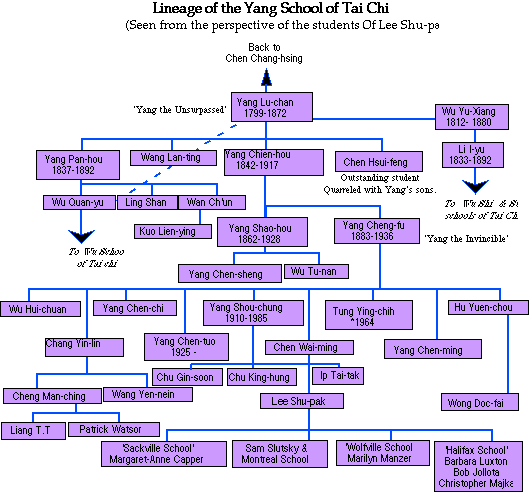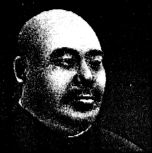History
Southern School
New Frame Style
Yang Style
Old Frame Style
Wu Style
Wu Shi Style
Sun Style

The yang style of Tai Chi

Yang Lu-chan was born in 1799 in Yung-nein in the prefecture of Kuang-p'ing in the province of Hopeh in China. There are several versions of his early life. One maintains that his family were farmers but his father soon noticed an interest in his son in martial arts. He arranged for lessons for him from a teacher named Liu. Yang Lu-chan soon mastered all his teacher could teach him and wanted to know more. Liu told him about Tai Chi Chuan, the secret of the Chen Family, but said that it was impossible for outsiders to learn the form.
Undeterred Yang Lu-chan set out for Hui-hsing in Hunan province where he managed to get employment as a servant in the household of Chen Chai-kou. At this household there was a famous teacher of Tai Chi, Chen Chang-hsing who was teaching the form to the young men there. Yang spied on them and at night practiced what he had seen.
After some time Chen Chiang-hsing happened to see him practicing one evening and realized the excellence of his technique. He decided to break with the tradition of secrecy and invited Yang into the school. Other accounts of Yang Lu-chan's early life claim that he came from very poor circumstances and was a bonded worker in a pharmacy before coming to Chen Chang-hsing's attention.
In any case, after some period of study, so great was his mastery of the form that Chen dismissed him and Yang returned to Yung-nein to teach martial arts. Later, one of his students Wu Yu-xiang, recommended that he go to Beijing to propagate the art. Yang eventually established a school of Tai Chi there, although not without some difficulties. In time he taught Tai Chi to the Imperial court and became known as 'Yang the Unsurpassed'.
Yang Lu-chan had three sons: the first Yang Ch'i died in early youth. His other two sons, Yang Pan-hou (1837-1892) and Yang Chien-hou (1842-1917) both continued to study and practice Tai Chi with their father, although perhaps not as diligently as he would have liked. One account claims that after his death an outstanding student Chen Hsui-feng, proclaimed himself the head of the Yang Family school and split with Yang's son's. In time, however, the two factions were reconciled.
Yang Cheng-fu.

Yang Pan-hou apparently became a very adept practitioner of Tai Chi, however he found few that he could work with. He had three students Ling Shin, Wan Ch'un (or Wang Kiu-yu) and Wu Quan-yu (or Wu Chuan-yuck). The first left no students, the second taught only Kuo Lien-ying. The third Wu Quan-yu taught Wang Mou-chai and Ch'i Ko-ch'en as well as his son Wu Chien-chuan. The latter, dissatisfied with the Yang style created his own style called Wu Style which he taught to his son Wu Kung-yi and Cheng Wing-kwong who carried on the Wu Style. Consequently the Yang tradition died out on this side of the family.
Yang Chien-hou also had three children. The eldest Yang Shao- hou (1862-1928) [also known as Yang Chao-hsuing]. He had one son Yang Chen-sheng who he taught his art to. The second son Yang Chao-yuan died early in youth. The third son, Yang Cheng-fu (1883-1936) [also known as Yang Ch'eng-pu and Yang Chao-ch'ing] is in large measure responsible for the popular transmission of the Yang Family Style to many people in the east and west.
Yang Cheng-fu practicing Tai Chi.


Known as 'Yang the Invincible' he had four sons; the eldest Yang Chen- Ming (also known as Yang Shou-chung); the second Yang Chen- chi; the third Yang Chen-tuo; and the fourth Yang Chen- kuo. He also had a number of outstanding students including Wu Hui-chuan, Chang Yin-lin, Tung Ying-chih, Hu Yuen-chou and Chen Wai-ming.
Chen Wai-ming taught Tai Chi in Shanghai in the 1930's and 40's before the revolution. He had four senior students to whom he passed on his innermost secrets and teachings. One of these was Lee Shiu-pak who after the revolution found himself in Hong Kong and began teaching Tai Chi there. Later on he emigrated to Canada and settled in Montreal where he established a school. His various students in Eastern Canada have gone on to carry on his and the Yang Family tradition.
For more detailed information on the historical development of these styles of Tai Chi see:
- The Historical Development Of Yang Tai Chi Chuan by Peter Lim
- Yang Style Tai Ji Quan History by Ted Knecht
- Take a look at Peter Lim's newest article on Combat Yang Taijiquan.